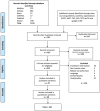Resuscitative endovascular balloon occlusion of the aorta (REBOA): indications: advantages and challenges of implementation in traumatic non-compressible torso hemorrhage
- PMID: 31245615
- PMCID: PMC6560484
- DOI: 10.1136/tsaco-2018-000262
Resuscitative endovascular balloon occlusion of the aorta (REBOA): indications: advantages and challenges of implementation in traumatic non-compressible torso hemorrhage
Abstract
Background: Resuscitative endovascular balloon occlusion of the aorta (REBOA) is regaining popularity in the treatment of traumatic non-compressible torso bleeding. Advances in invasive radiology coupled with new damage control measures assisted in the refinement of the technique with promising outcomes. The literature continues to have substantial heterogeneity about REBOA indications, applications, and the challenges confronted when implementing the technique in a level I trauma center. Scoping reviews are excellent platforms to assess the diverse literature of a new technique. It is for the first time that a scoping review is adopted for this topic. Advances in invasive radiology coupled with new damage control measures assisted in the refinement of the technique with promising outcomes. The literature continues to have substantial heterogeneity about REBOA indications, applications, and the challenges confronted when implementing the technique in a level I trauma center. Scoping reviews are excellent platforms to assess the diverse literature of a new technique. It is for the first time that a scoping review is adopted for this topic.
Methods: Critical search from MEDLINE, EMBASE, BIOSIS, COCHRANE CENTRAL, PUBMED and SCOPUS were conducted from the earliest available dates until March 2018. Evidence-based articles, as well as gray literature at large, were analyzed regardless of the quality of articles.
Results: We identified 1176 articles related to the topic from all available database sources and 57 reviews from the gray literature search. The final review yielded 105 articles. Quantitative and qualitative variables included patient demographics, study design, study objectives, methods of data collection, indications, REBOA protocol used, time to deployment, zone of deployment, occlusion time, complications, outcome, and the level of expertise at the concerned trauma center.
Conclusion: Growing levels of evidence support the use of REBOA in selected indications. Our data analysis showed an advantage for its use in terms of morbidities and physiologic derangement in comparison to other resuscitation measures. Current challenges remain in the selective application, implementation, competency assessment, and credentialing for the use of REBOA in trauma settings. The identification of the proper indication, terms of use, and possible advantage of the prehospital and partial REBOA are topics for further research.
Level of evidence: Level III.
Keywords: REBOA; balloon vascular occlusion; damage control occlusion of the aorta; resuscitative aortic occlusion; resuscitative balloon occlusion of the aorta; therapeutic occlusion of the aorta.
Conflict of interest statement
Competing interests: None declared.
Figures




References
-
- Rotondo MF, Schwab CW, McGonigal MD, Phillips GR, Fruchterman TM, Kauder DR, Latenser BA, Angood PA. 'Damage control': an approach for improved survival in Exsanguinating penetrating abdominal injury. J Trauma 1993;35:375–82. discussion 382-373. - PubMed
-
- Meizoso JP, Ray JJ, Karcutskie CA, Allen CJ, Zakrison TL, Pust GD, Koru-Sengul T, Ginzburg E, Pizano LR, Schulman CI, et al. . Effect of time to operation on mortality for hypotensive patients with gunshot wounds to the torso. J Trauma Acute Care Surg 2016;81:685–91. 10.1097/TA.0000000000001198 - DOI - PubMed
-
- Brenner M, Inaba K, Aiolfi A, DuBose J, Fabian T, Bee T, Holcomb JB, Moore L, Skarupa D, Scalea TM, et al. . Resuscitative Endovascular Balloon Occlusion of the Aorta and Resuscitative Thoracotomy in Select Patients with Hemorrhagic Shock: Early Results from the American Association for the Surgery of Trauma’s Aortic Occlusion in Resuscitation for Trauma and Acute Care Surgery Registry. J Am Coll Surg 2018;226:730–40. 10.1016/j.jamcollsurg.2018.01.044 - DOI - PubMed
LinkOut - more resources
Full Text Sources
Research Materials
